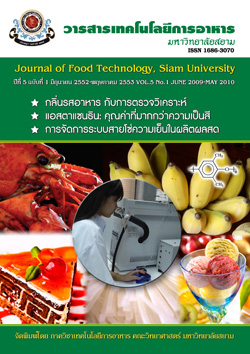การผลิตเส้นก๋วยเตี๋ยวจากแป้งข้าวหอมนิล
Main Article Content
Abstract
งานวิจัยนี้ได้ทำการศึกษาการผลิตก๋วยเตี๋ยวเส้นใหญ่ด้วยการใช้แป้งข้าวหอมนิลทดแทนแป้งข้าวเจ้า บางส่วน โดยแปรอัตราส่วนแป้งข้าวหอมนิลเป็นร้อยละ 0, 5, 10, 15, 25, 30, 40 และ50 (โดยน้ำหนักแป้งข้าวเจ้า) พบว่าสามารถใช้ทดแทนแป้งข้าวเจ้าได้ โดย องค์ประกอบทางเคมีของก๋วยเตี๋ยวเส้นใหญ่ที่ผลิตได้ คือ ความชื้น, เถ้า, โปรตีน, ไขมัน, เส้นใย และ คาร์โบไฮเดรตเป็นร้อยละ 67.18 - 68.77, 0.09 - 0.5, 2.5 - 6.73, 0.71 - 0.76, 0 - 0.37 และ 23.54 - 29.90 ตามลำดับ และให้ค่าพลังงาน 2.60- 5.00 kcal/g จากนั้น นำไปทดสอบการยอมรับด้วยวิธี 9-point hedonic scale และเปรียบเทียบลักษณะของผลิตภัณฑ์ก๋วยเตี๋ยวเส้นใหญ่ด้วยวิธี QDA พบว่าการทดแทนแป้งข้าวหอมนิลในก๋วยเตี๋ยวเส้นใหญ่ที่ร้อยละ 25 (โดยนำ้หนักแป้งข้าวเจ้า) ได้รับการยอมรับมากท่ีสุดและมีลักษณะท่ีบ่งบอกถึง คุณภาพของก๋วยเตี๋ยวเส้นใหญ่ใกล้เคียงกับสูตร มาตรฐาน ซึ่งก๋วยเตี๋ยวเส้นใหญ่ที่ผลิตได้มีสีม่วงเทาให้ความเหนียวและความยืดหยุ่นดี โดยมีค่า tensile strength เท่ากับ 50.55 กรัม และ break distance เท่ากับ 18.40 มิลลิเมตร และเมื่อเปรียบเทียบคุณค่าทาง โภชนาการของก๋วยเตี๋ยวเส้นใหญ่ท่ีทดแทนด้วยแป้งข้าวหอมนิลร้อยละ25 (โดยน้าหนักแป้ง) พบว่าปริมาณ ความชื้น เถ้า โปรตีน และเส้นใยสูงกว่าสูตรมาตรฐาน ร้อยละ 1.59, 0.17, 3.00 และ 0.04 ตามลำดับ
The production of noodle from Hom Nin rice flour
This research studied the production of big - sized noodle using rice flour partially substituted with Hom Nin rice flour at 0%, 5%, 10%, 15%, 25%, 30%, 40% and 50% (by rice flour weight). The chemical composition of them such as moisture, ash, protein, lipid, fiber, and carbohydrate was 67.18 – 68.77%, 0.09 – 0.5%, 2.5 – 6.73%, 0.71 – 0.76%, 0 – 0.37% and 23.54 – 29.90%, respectively and energy was 2.6 – 5 kcal/g. Consequently, analytical of sensory evaluation and acceptance with 9 – point hedonic scale and QDA method, found that the content of 25% (by rice flour weight) Hom Nin rice flour was the highest overall acceptance and it had the quality resemblance to the standard big - sized noodle. The characteristic of this sample was gray – purple color, gumminess and good flexibility. The tensile strength was 50.55 g., break distance was 78.4 mm. Moreover the data showed that this sample was higher moisture 1.59%, ash 0.17%, protein 3%, and fiber 0.04% when compared with the control.
Article Details
Copyrights of all articles in the Journal of Food Technology available in print or online are owned by Siam University and protected by law.


